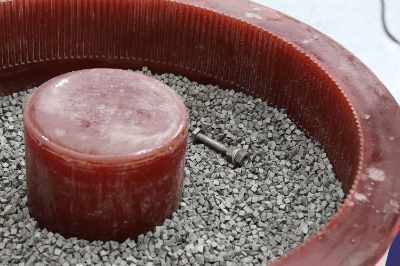What Is Barrel Finishing Machine?
 Barrel finishing machine is a general term for machines that polishes objects through friction by moving abrasives in a barrel container.
Barrel finishing machine is a general term for machines that polishes objects through friction by moving abrasives in a barrel container.
The polishing technique used in barrel finishing machine is an essential part of manufacturing, as it is the final step in the manufacturing process to finish the surface. By removing burrs and rounding off corners, barrel finishing machine can handle surface finishing in a batch process.
By combining abrasives and polishing aids called compounds, a single machine can perform a wide range of polishing processes such as mirror finishing, deburring, radiusing, and descaling.
Barrel machines provide a uniform finish with little variation, and there are almost no difference in quality between operators. Moreover, since multiple products can be polished at once, barrel finishing machines are widely used for a wide range of products.
Uses of Barrel Finishing Machine
Barrel machines are used to polish and finish the surface of machined, pressed, sintered, die-cast, and heat-treated products. They can polish not only metals but also plastic and glass products.
They also perform finishing, matting, and degreasing of the surface before plating or painting.
As a result, they are used for a wide range of products, but are not suited for large or fragile products.
Specifically, barrel machines are used to polish parts for TVs, automobiles, digital cameras, and cellular phones, as well as wrenches and aluminum wheels.
Features of Barrel Finishing Machine
Barrel machines are characterized by their ability to simultaneously polish a large number of objects at one time. Compared to buffing, which is a similar polishing method, they is characterized by their ability to polish and deburr metals at a lower cost. Another feature of barrel finishing is that the quality after polishing can be more uniform than with manual polishing.
One of the disadvantages of barrel finishing is that it requires a large barrel tank that can hold the entire object. If a large barrel tank is not available, other methods such as buff polishing must be used.
In the case of barrel polishing, mixing by equipment makes it possible to achieve a consistent finish regardless of the person in charge of the operation. Also, since multiple products can be fed into a barrel container, a large quantity can be polished at once.
Types of Barrel Finishing Machine
Barrel machines polish an object by friction when the object, abrasive, and compound are placed in the barrel together and moved. Barrel finishing machines are similar to washing machines in that they can polish metals in a batch.
There are three main types of barrel finishing machine:
1. Rotary Polisher
Rotating the barrel causes the contents to rub against each other at the sliding layer, resulting in polishing. Although it requires extra processing time and labor, a rotary polisher is characterized by its ability to produce a stable finish.
Barrels used are mainly hexagonal or octagonal in shape, but there are also tiltable barrels for easy ejection. Rotating the inside of the barrel allows for slow polishing, resulting in a soft surface finish.
2. Vibratory Grinder
Box and circle type barrels are available, and polishing is performed by vibrating the barrel. The advantages are ease of operation and ease of automation. Suitable for mass production and for large or long products because it can feed a large number of products, however are otherwise expensive to manage.
3. Centrifugal Grinder
Multiple barrels rotate in a combination of spinning and revolving to polish. The centrifugal grinder is suitable for polishing small objects, it has the highest polishing power, and requires the shortest processing time. It is easy to automate but expensive, however its disadvantage is that the condition of the workpiece cannot be checked during processing.
Abrasives and abrasive stones include vitrified materials, alumina materials, plastic materials, soft materials, steel materials, and dry materials, and there are as many as 1,500 different patterns depending on the finishing application. Compounds can be liquid or solid, and their roles are varied, including as degreasers, rough finishers, bright finishers, rust inhibitors, and lubricants.